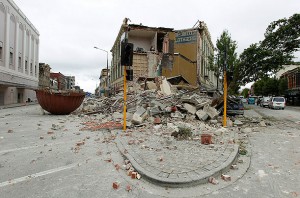In a reminder that catastrophe claims are not always settled rapidly and that it can take some years before the final insurance industry loss and impact to reinsurance markets is clear, IAG has revealed another deterioration in its loss due to the 2011 Canterbury, New Zealand earthquakes.
 In announcing its latest results, Insurance Australia Group (IAG) revealed that it had to further strengthen its reserves for the 2011 NZ quakes, taking its gross claims above the $4 billion (USD$2.7 billion) group reinsurance program limit.
In announcing its latest results, Insurance Australia Group (IAG) revealed that it had to further strengthen its reserves for the 2011 NZ quakes, taking its gross claims above the $4 billion (USD$2.7 billion) group reinsurance program limit.
That means that global reinsurers won’t be on the hook for anymore of IAG’s claims, now it has passed that reinsurance limit, but it does mean that some additional losses will have been passed on as IAG’s claims reached that point.
IAG strengthened its gross claim reserves related to the Canterbury earthquakes by around $150m in the financial year, the bulk of that at the end of 2014 and the remainder just at the end of its financial year around June 2015.
The final increase in reserves has now tipped the insurer beyond its reinsurance cover, exhausting the full $4 billion limit on the group’s program. IAG says it has paid $4.5 billion of claims, or 78% in number.
IAG provided some insight as to the cause of the deterioration; “This strengthening has been driven by the continuing notification of new household claims that have exceeded the Earthquake Commission’s residential dwelling limit and, to a lesser extent, an increase in forecast repair costs and a series of adverse court judgements which have affected the broader insurance industry.”
It’s a good reminder that catastrophe claims, particularly for earthquakes, do not always settle quickly. Slow claims development after loss events has ramifications for catastrophe bond indemnity coverage, or collateralized reinsurance, which can see claims develop for some time resulting in collateral being locked up sometimes for months or years.
In the case of the 2011 Canterbury New Zealand earthquakes, the majority of reinsurance claims were settled earlier, based on estimates, with some collateralized coverage having been settled through commutation meaning that there can’t be anymore adverse development suffered.
Of course, the rise in IAG’s losses could mean that other companies have also suffered some deterioration. While this deterioration won’t impact the insurance-linked securities (ILS) market directly, as reinsurance and retrocession claims that fell to ILS funds were settled long ago as we understand it, it could hit some reinsurers a little who hadn’t yet closed down losses.
Whether it results in anymore loss to reinsurers or not the New Zealand quakes have been a prime example in the difficulty in settling catastrophe loss claims and how they can escalate over time.
It’s something that ILS investors and ILS fund managers need to be aware of, as they enter into reinsurance agreements, that there are cases where the final settlement can take time and if you get a chance to commute the loss early it might (in some cases) be the best option.
Also worth remembering that the New Zealand Earthquake Commission is looking to catastrophe bonds for its own reinsurance in future. If claims in that country can take so long to escalate, with some of the reason being the Commission’s influence, perhaps a parametric trigger would be best?
Reinsurers may be more concerned about claims coming from 2015 weather and catastrophe losses suffered by IAG, with the insurer reporting $1.048 billion of losses in its financial year, causing its $375m deductible for the 2015 aggregate reinsurance cover to be entirely eroded. IAG has now eaten into its $450m aggregate layer, reporting a $70m hit to its reinsurers today.
That means any future catastrophe events during the year will now likely eat into that aggregate layer, creating further losses for reinsurers as well as any collateralized players that have participated. IAG now has $280m of aggregate cover left to the end of the year.
 View all of our Artemis Live video interviews and subscribe to our podcast.
View all of our Artemis Live video interviews and subscribe to our podcast.
All of our Artemis Live insurance-linked securities (ILS), catastrophe bonds and reinsurance video content and video interviews can be accessed online.
Our Artemis Live podcast can be subscribed to using the typical podcast services providers, including Apple, Google, Spotify and more.































